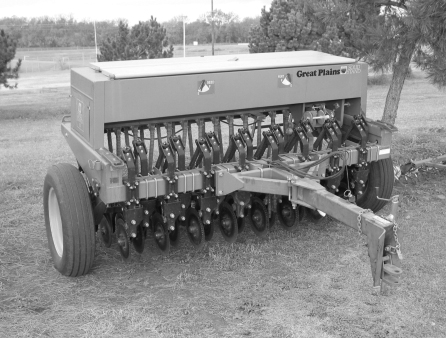Calibration Procedure for Canola Planted with an End-Wheel Grain Drill (Volumetric Method)
Obtain the Following Materials:
- Two syringes without needles (one 10 to 15 CC or Ml and one 50 CC or Ml) 1 CC = 1 Ml
- Four to six plastic bags about 1 quart or sandwich bag size
- Six to eight rubber bands
- Jack and a measuring tape
Grain Drill Preparation:
- Determine seeding rate. Typical seeding rate for winter canola production in Oklahoma is 5 lbs/acre.
- Set the drill to the canola or rapeseed setting in your planter book. This may be close to 0. In some situations a slow down kit for the drill or plugging every other hole may be required.
- It is usually easier to calibrate a grain drill (if you are able) to lift the drive wheel off the ground. This will allow the drive wheel to be rotated by hand rather than pulling the drill 100 feet back and forth.
- Jack up the drive wheel on the grain drill or measure out 100 feet to pull the grain drill.
- Make sure the gears on the drill are engaged.

Figure 1.
Determining drive wheel revolutions for 100 feet
Measure the height of the drill wheel. Using the following equations, determine the number of revolutions the wheel will have to make in order to travel the distance of 100 feet.
- (height of tire in inches) x (3.14) ÷ 12 = feet per revolution
100 feet = # wheel revolutions feet per revolution
Example: 30 inch tire
- (30 inches X 3.14) / 12 = 7.85 feet per revolution
- Then figure the number of revolutions to cover 100 feet.
- (100 ft) / 7.85 = 12.8 complete wheel revolutions to cover 100 feet.
Calibration
- Put enough seed into the grain box to ensure that it will not run out, and “prime” the drill by either turning the drive wheel by hand or by pulling it forward, depending on the method you chose.
- Make a mark on the drive wheel to use as a reference when counting wheel revolutions.
- Attach bags over drop tubes with rubber bands (try to collect from at least four openers) and turn the drive wheel the set number of revolutions for 100 feet or pull the drill forward 100 feet.
- Collect the amount of seed discharged from one, two, or four openers.
- Use the table below to determine how much canola you should catch in each bag based on the grain drill’s row spacing and how many rows were collected into one bag.
Note: Make sure all rows are feeding undamaged seed. If one is not putting out seed, or one is grinding the seed, then you need to plug every other hole. Then redo calibration, catching twice as much seed out each seeding opener. Many growers have gone from 7.5-inch to 15-inch rows because of trouble calibrating a small amount of seed in an older drill. Research data has shown that canola can be planted at a rate of 5 lbs/A with 6-inch to 16-inch row spacing’s with little effect on final yield.
Plugging every other row from the start makes drill calibration easier and helps improve overall crop stand.
Recalibrate whenever different varieties are used because seed size (seeds/lb) may change, depending on the variety/hybrid.
Table 1. Total Volume Collected/100 Feet (CC or MI)
| Row Spacing | 1 Row | 2 Rows | 4 Rows |
|---|---|---|---|
| 6" | 3.6 | 7.2 | 14.4 |
| 7" | 4.2 | 8.4 | 16.8 |
| 7.5" | 4.6 | 9.3 | 18.6 |
| 8" | 5 | 10 | 20 |
| 10" | 6.2 | 12.4 | 24.8 |
| 14" | 9 | 18 | 36 |
Mark C. Boyles
Canola Extension Specialist
Josh Bushong
Canola Extension Specialist
